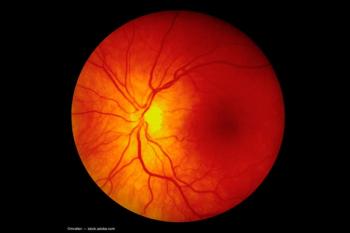
SAHARA trial demonstrates sustained TearCare benefits for evaporative DED
Key Takeaways
- The SAHARA trial confirms TearCare's long-term efficacy in treating dry eye disease, with sustained improvements after one or two treatments over two years.
- TearCare demonstrated significant improvements in clinical signs and patient-reported symptoms, with a low retreatment rate and no serious adverse events.
New findings confirm TearCare's long-term effectiveness for dry eye disease, showing significant patient improvements with minimal treatments over 2 years.
Newly published 24-month results from the SAHARA randomized controlled trial (NCT04795752) confirm the long-term efficacy of the TearCare System (Sight Sciences) for treating
Published in Optometry and Vision Science, the stage 3 results of the SAHARA trial tracked 166 participants who received an initial TearCare treatment followed by a second at month 5. Over the remaining 19 months, 66% required no further therapy, and only 7% required a third or fourth treatment. The median time to retreatment was 7 months. Clinical signs and patient-reported symptoms remained significantly improved at all follow-up intervals through month 24 (P<.0001).1
“These results demonstrate the durability, repeatability, and significant clinical benefits of treatment with TearCare in a landmark device-versus-drug RCT,” said Paul Badawi, co-founder and chief executive officer of Sight Sciences.
“We were pleased to see the 24-month SAHARA RCT data confirm that participants achieved and maintained clinically significant improvements in all signs and symptoms of DED with one to two TearCare treatments per year.”1
Objective improvements were observed across several standard measures. Tear break-up time (TBUT) increased from 4.41 seconds at baseline to 6.29–7.13 seconds at follow-up. Meibomian gland secretion scores (MGSS) rose from 7.26 to approximately 18.9, while other parameters, including MGYAL, MGYCL, corneal and conjunctival staining, and Schirmer scores, also demonstrated sustained benefit. Subjective assessments, including the Ocular Surface Disease Index (OSDI), Symptom Assessment in Dry Eye (SANDE), and Eye Dryness Score (EDS), showed continued improvement through month 24. No serious adverse events were reported, demonstrating the safety of the procedure across a diverse patient population.1
Unlike pharmacologic treatments such as Restasis (cyclosporine ophthalmic emulsion, 0.05%), which rely on consistent patient adherence to twice-daily dosing, TearCare offers an interventional, in-office approach with consistent efficacy independent of daily patient behavior. This may result in more predictable outcomes in real-world settings. Given the chronic nature of evaporative DED and common barriers to long-term drop adherence, this procedural strategy represents a meaningful shift in care. Additionally, TearCare’s design, providing localized inner eyelid heat with concurrent external pressure, allows patients to keep their eyes open during treatment, potentially improving comfort and compliance compared to traditional warm compresses or manual expression.2,3
The mechanism of TearCare’s benefit involves both physical relief of meibomian gland obstruction and reduction of ocular surface inflammation. Thermal pulsation therapy has been shown to decrease levels of inflammatory chemokines such as IP-10 and MIG, which are elevated in meibomian gland dysfunction (MGD) and contribute to tear film instability. Notably, reductions in IP-10 correlate with improved meibum quality and TBUT, suggesting that TearCare’s anti-inflammatory effects play a role in restoring ocular surface homeostasis.2
The SAHARA RCT was conducted in 3 stages. Stage 1 compared TearCare to Restasis, with TearCare showing superior improvements in TBUT. In stage 2, participants initially assigned to Restasis were crossed over to TearCare after 6 months and demonstrated further clinical gains following a single treatment. Stage 3 evaluated durability, determining optimal retreatment intervals over the full 24-month period. With the majority of patients requiring only 1 or 2 treatments annually, TearCare may reduce treatment burden while offering a convenient, durable solution for managing chronic DED.1
The SAHARA trial supports the clinical evidence regarding TearCare as an interventional option for managing evaporative DED. With sustained improvements in both signs and symptoms over 2 years and a low retreatment rate, the device may offer a practical alternative to pharmacologic therapies, particularly for patients with MGD. Its performance in a head-to-head trial design contributes valuable data to ongoing discussions around long-term treatment strategies in dry eye care.
References:
Sight Sciences Publishes 24-Month SAHARA RCT Results Evaluating TearCare in Dry Eye Disease - Eyewire+. Eyewire+. Published 2025. Accessed August 7, 2025. https://eyewire.news/news/sight-sciences-publishes-24-month-sahara-rct-results-evaluating-tearcare-in-dry-eye-disease?c4src=article:infinite-scroll
Liu W, Lin T, Gong L. Meibomian gland dysfunction patients benefit in ocular parameters and tear chemokines after thermal pulsation treatment. International Journal of Medical Sciences. 2023;20(1):11-22. doi:https://doi.org/10.7150/ijms.76603
Charters L, Bloomenstein MR. Phase 1 device vs. drug SAHARA results. Optometry Times. Published October 25, 2023. Accessed August 7, 2025. https://www.optometrytimes.com/view/phase-1-device-vs-drug-sahara-results
Newsletter
Don’t miss out—get Ophthalmology Times updates on the latest clinical advancements and expert interviews, straight to your inbox.













































